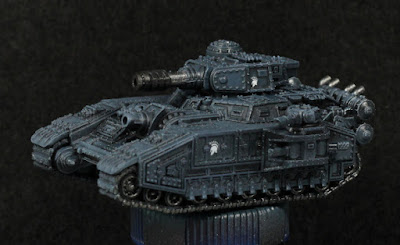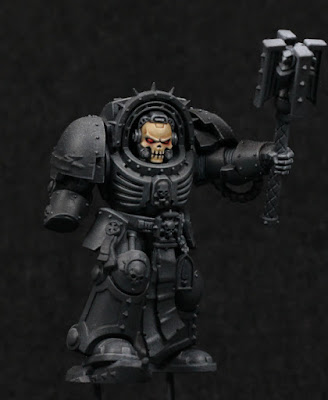 |
| Head hunting. |
One of the first models that I painted when I got back to painting was Commander Dante. That was a finecast model, and I had painted the metal version long ago (and had also given that army away long ago). The new, Primaris, Command Dante is an excellent update to that old sculpt. The basic design remains the same, but has been updated with modern approaches to miniature design, and of course a slightly larger scale.
I was thinking for quite some time about how to paint the new model. I wasn't going to do NMM, but I also didn't want to go for a simple approach - I wanted to try use metallics to push the envelope and see what I could do with them.
Originally I tried to base coat with the airbrush using Balthasar Gold. I was definitely leaning towards the original paint scheme itself and I like the darker colour that gives a more antique and master crafted feel to the armour. Unfortunately I forgot to first base coat with Rhinox Hide, and didn't know how to properly thin airbrush paints at the time. The result was very poor coverage with an awful lot of speckling, and black does not work as a shadow colour here.
After a very long time trying to think how I might want to fix airbrushing mistakes, I finally decided to simply go in with a brush using the same colours and smooth out the initial highlight volumes. The airbrushing, for all of the mistakes I made, still shows the volumes nicely and gives a great idea of where to place highlights. It's about here where I thought to deviate slightly and take some hints from the idea of painting NMM, but with metallic paints.
Only the left leg has been started because I wasn't sure how it would turn out and figured the legs wouldn't draw as much attention as the face, but do offer a large enough space to get an idea about how the rest would end up. All I did was mix Rhinox Hide and Balthasar Gold in varying ratios, layering and glazing over the volumes. The Rhinox Hide dulls out the Balthasar Gold, giving a very satisfying satin finish - highlights are certainly more reflective than shaded areas, but not excessively so. Flow improver helps to thin the mixture, and I'm starting to experiment with Lahmian Medium to slightly dull the more "pure" metallic glazing. I do want contrast in surface finish (more matt in the shadows, satin or slightly gloss on the brighter points), but I want more control over it and I'm hoping the medium will permit that.
I'm quite pleased with the result so far. I've already started on the "face" (helmet) and have highlighted that up further with Gehenna's Gold and Auric Armour Gold along the same lines. Gehenna's Gold has some Rhinox Hide mixed in mostly for the surface finish, and while it works I'm still considering pushing it a bit further. The details need more highlight contrast to properly make them out, which is something often missed when using magnifying glasses all the time.
-- silly painter.















